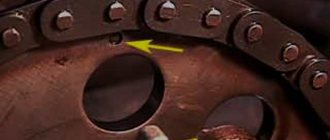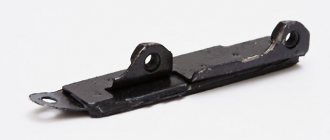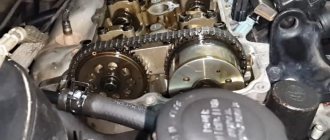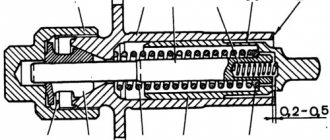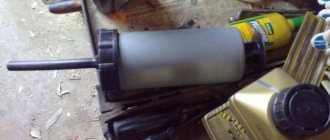A timing chain is a more reliable and durable solution compared to a belt. However, during operation, it is important to monitor the condition and degree of tension of the chain, and also replace it when the first signs of a malfunction appear.
As a rule, the timing chain is changed:
- according to regulations and mileage (average resource is 120-150 thousand km);
- in case of extraneous noise during engine operation;
- as a result of problems with the chain tensioner or breakdown of other elements;
- as part of a comprehensive service or timing belt replacement;
- when the chain is stretched, which is detected during inspection, etc.
The chain of the Peugeot 308 and other models of this brand with an EP6 naturally aspirated or turbo engine also has a fairly limited resource. As a rule, an EP6 chain lasts about 100-120 thousand km. At the same time, replacing the Peugeot timing chain can easily be done with your own hands if necessary. Read more in our article.
How to check timing chain tension
If you suspect that the Peugeot 308 chain needs to be replaced, before starting the replacement you must first check how much the chain is stretched. The fact is that in some cases the problem may not be with the chain. To check the hood, you will need to have a special device.
This device is called a tensioner template and allows you to measure the degree of stretch of the timing chain. This template is sold both separately and as a set with a kit for fixing timing marks.
- On the EP6 motor, the template must be screwed in instead of the tensioner. First, the internal pin is unscrewed, then it is twisted along the main thread by hand until it stops slightly. Please note, there is no need to tighten too much!
- After tightening the template, you can take measurements using a ruler or caliper. For an EP6 naturally aspirated engine, the norm is up to 73 mm. As for the EP6DT version, up to 71 mm is allowed.
It is quite obvious that if the chain is stretched, the element needs to be replaced. Also, replacing the chain is strongly recommended if the Peugeot timing belt is being replaced, and the chain drive has already worked for about 50-60 thousand km.
After making sure that the Peugeot 308 chain needs to be replaced, you need to prepare a suitable place for the work, the necessary tools and spare parts. It is more convenient to work in a garage where there is a lift, but all operations can be performed using jacks.
Features of the timing drive
The Peugeot 308 is equipped with a durable and technologically advanced EP6 engine. It is naturally aspirated, which means that there are no turbines or intercoolers in it. This engine can also be found on other Peugeot models, for example on the 308. If you have little experience, then it is better to entrust serious engine repairs to professionals.
But if we are only talking about replacing the chain, then you can deal with this problem in one evening. But you need to know when to replace it, as well as the location of all the marks on which the camshafts and crankshafts are installed. We will talk about this in our article.
Tools and spare parts
To replace the timing chain, you will need the following basic spare parts:
- camshaft gear;
- timing chain drive gear;
- valve cover gasket;
- sealing washer;
- crankshaft bolt;
- camshaft bolt;
- timing chain guide bolt;
- crankshaft pulley bolt;
- chain tensioner;
- timing chain;
- timing chain guide right, left and top.
As for tools, you need a kit for installing timing marks on a Peugeot with an EP6 engine (you can take Licota, JTC, etc.). You will also need wrenches (small, large), heads 18 for the crankshaft pulley bolt 10, for unscrewing the valve cover 8, for unscrewing the upper damper 27.
You will also need a T40 Torx for the chain tensioner and camshaft bolts, a T30 Torx for unscrewing the lower dampers, and a 16mm wrench for removing the throttle block (for the atmospheric engine). You will also need keys to remove the support near the motor block, etc. It is also necessary to have a torque wrench to tighten the fasteners to the correct torque during reassembly.
Checking chain wear
Set of shaft clamps and drive chain tensioner.
The device is a complex threaded bushing that is screwed in instead of the standard tensioner. First, screw in a large threaded bushing without using keys, by hand. The rod is screwed into this bushing until it stops, also only by hand. After this, the device is turned out of the socket and the length of the rod is measured from the beginning of the threaded part of the sleeve. The permissible chain stretch ratings are :
Tools and necessary spare parts for replacement
If measurements show that the chain slack exceeds the nominal value, we prepare for replacement and buy spare parts according to the catalog numbers indicated in the table.
| Part name | Catalog no. |
| New timing chain, original | 0816-N9 |
| Intake camshaft toothed pulley (gear) | 0805-K1 |
| Exhaust camshaft toothed pulley (gear) | 0805-K3 |
| Two camshaft seals for intake | 0807-39 |
| Crankshaft toothed pulley (gear) | 0513-C8 |
| Two new disposable camshaft gear bolts | 0806-77 |
| Timing chain tensioner | 0829-G3 |
| Upper chain guide, original | 0 818-41 |
| Right chain guide | 0818-30 |
| Left chain guide | 0818-33 |
| Crankshaft hub | 0513-E1 |
| Crankshaft oil seal | 0514-C8 |
| Crankshaft hub fixation bolt, disposable | 0516L8 |
| Valve cover gasket | 0249-E7 |
Depending on the condition of the engine, other fasteners and wear parts may be needed. Here is a list of tools, not including a set of special devices :
How to change the timing chain of a Peugeot 308
Replacing the timing chain of a Peugeot 308, or rather the timing chain on an EP6 engine, involves removing the right engine mount and installing the flywheel mark. Taking into account the fact that these elements are located in the lower part of the power unit, it is more convenient to perform this procedure on a lift. If there is no lift, you need to jack up the front of the car.
The following is disassembly:
- First, unscrew the air filter housing (remove it from the guides and move it to the side);
- Next you need to unscrew the valve cover and remove the cover from the engine;
- Next, using the 18 head and knob, you need to turn the crankshaft pulley, aligning the shafts so as to set the marks at the bottom.
- If the marks are missing, it is prohibited to turn the shaft counterclockwise! (it is better to turn the shaft forward two turns);
- Next, you can remove the engine protection (if equipped), jack up the car and install the bottom mark in the hole;
- then you need to unscrew the right wheel, then you also need to remove the locker;
- if the chain is replaced using a jack, you need to place a block under the engine pan and lower the car on it so that the block supports the engine from below, then you can remove the right support;
- then a device is installed for the camshaft marks (to set the Peugeot timing marks);
- remove the generator belt and unscrew the pump drive roller (secured with three 10mm bolts);
- Now you need to unscrew the upper damper and chain tensioner, the crankshaft pulley, the 18 bolt (presses the lower sprocket support);
- the support should be removed from the oil seal, and it is better to replace the oil seal itself and install a new one;
- the next step is to remove the lower chain guides (unscrew 3 bolts);
- Next, the oil dipstick is removed (in the cylinder block, the dipstick passes through the timing chain guide);
- now you can pull the flail up along with the stabilizers and the lower sprocket;
- After removal, you can install a new chain, change other worn elements and parts, and then set the timing marks.
Please note that placing the crankshaft in the service position assumes that the pistons will be at the same level between TDC (top dead center) and BDC (bottom dead center). For this reason, you must first assemble the chain and guides before installation, and only then lower the timing belt to the installation site. Before lowering, it is important to thoroughly degrease the timing sprocket, as well as the crankshaft hub.
Main symptoms of failure
Among the main symptoms that clearly indicate that the chain in the Peugeot 308 1.6 liter needs to be replaced are the following:
- The noise level is too high when the engine is idling and at low speeds.
- Engine trouble, unstable starting.
- Oil consumption increases. It is worth considering that the norm is up to 0.5 liters for every 1000 km.
- Gasoline or gas consumption increases (depending on what the engine is running on).
- During diagnostics, the engine control unit may indicate the presence of an Antipollution system faulty error. It is also possible that other errors may appear that are related to the timing system.
- The Check Engine light comes on.
It's also worth noting that there may be more symptoms, so it's best to go by mileage. You also need to pay attention to the fact that in some cases mileage is not a significant indicator. For example, in cities, cars cost more than they drive. Therefore, it makes more sense to switch to an engine hour count rather than track mileage.
Tightening torque and reassembly
As you can see, on an ep6 motor, replacing the chain is a complex procedure, but it requires special tools and skills. It is also important to know with what torque (force) to tighten previously unscrewed bolts. This information is in the manual, it is recommended that you read it before starting assembly.
For example, the tightening of the chain tensioner with a torque wrench is 8.5 da.N.m, the stabilizer bolts are 2.5, the crankshaft hub mounting bolt is 5, the attachment pulley bolts are 2.8, the phase shifter mounting bolt is 2, the camshaft sprocket is 2, etc.
We also recommend reading the article about which drive is better, a timing chain or a belt. In this article you will learn about the advantages and disadvantages of various types of timing gear drives.
It is also recommended to lubricate the crankshaft sprocket mounting bolt with so-called liquid fixative. It is also important not to make mistakes when installing phase shifters on the intake and exhaust shafts (the intake is marked IN35, the exhaust is EX30).
When is replacement needed?
Despite the rather flimsy appearance of the timing chain, it has a long service life. On atmospheric EP6 engines it lasts for about 170 thousand km. But this is subject to the condition that all technical regulations will be unquestioningly observed, and the attitude towards the engine will be as careful as possible. But even if the engine is not naturally aspirated, but with a turbine, the timing drive lasts about the same. But there are minor nuances when diagnosing the condition of the timing chain; we will definitely mention this in our article.
The repair procedure is no different for naturally aspirated and turbocharged types. It is worth noting that a break is unlikely to occur, so replacement should only be carried out if certain symptoms are present, which are sometimes quite difficult to identify. Now we will look at all the symptoms that indicate that the timing drive needs to be repaired.
Professional inspection of EP6 / EP6 TD engine belts at AvtoPSA
The problem with diagnosing the entire timing belt assembly is saving on diagnostic tools. Multi-brand gadgets connected to diagnostic lines only show generic codes that don't tell you much. A certified service center must “catch” specific errors, otherwise serious problems may arise. For example, from would-be repairmen you can hear a recommendation to replace the lambda probe, although in fact the car was giving signals precisely because the chain was highly stretched.
At AUTOPSA, owners of cars from the French concern can receive the following services:
- Firmware only with official diagnostic software from PSA. It is thanks to the programs that you can determine whether the timing rollers, chains, or both need to be changed. Versions of diagnostic software are always the latest and equivalent to the model being tested.
- Experienced technicians specializing in French cars will carry out the first visual diagnosis perfectly. It is no secret that the “French” have many non-trivial engineering solutions, as well as a rather non-standard arrangement of the car’s control electronics. Masters with twenty years of experience check everything personally and manually.
- Checking the deformation of parts of the timing belt assembly using high-precision diagnostic instruments. Such readings are guaranteed to provide readings on abrasion and deformation of belts and chains with an accuracy of almost hundredths.
Symptoms of a problem
If the chain has exhausted its service life, then some characteristic signs appear indicating its wear:
- When starting the engine at idle speed, a specific hum is heard;
- The engine does not start when the starter and ignition are working properly;
- The engine “stalls” at low speeds or idling;
- At sub-zero temperatures of the unit at idle speed the engine “troits”;
- Fuel consumption increases;
- Periodic smoky exhaust emissions.
But don’t forget about the car’s mileage. Therefore, even if there are no special signs of wear, and the mileage is high, it is necessary to regularly check the timing chain tension, since in the case of large stretching, the valves may come into contact with the pistons, which will entail a major overhaul of the engine. Timing chain breakage occurs quite rarely; most often, the main consequence of wear is its stretching.
If the above-described signs of wear on the timing chain appear, as well as when the “Check Engine” indicator appears on the instrument panel, it is necessary to carry out diagnostics at a service center, where specialists will determine the condition of the chain and, if necessary, adjust its tension or replace it with a new one.
